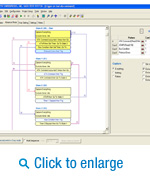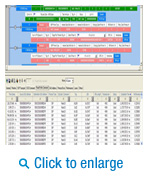Leveraging Teledyne LeCroy's extensive expertise in high-speed serial data analysis, the Sierra M124A provides the most accurate capture, display and analysis of both SAS and SATA protocol at data rates up to 12 Gb/s. This multifunction validation platform is available with an integrated traffic generator capable of mimicking real host and device behaviors. The error injection option allows stress testing at the system and component level. Combining best-in-class hardware capabilities with comprehensive analysis features, the Sierra M124A is the smart choice for SAS/SATA protocol test.
Flexible, Extensible 12G Protocol Test System
With four recording channels, the M124A can intelligently monitor and correlate traffic across 4-wide expander links. Cascade multiple Sierra M124A systems (up to 8) for monitoring traffic between adjacent 4-wide links. The Sierra M124A can be upgraded with traffic generation (Trainer) or error injection (InFusion) capabilities allowing this single platform to address both debug and verification tasks.
Unmatched Accuracy with T.A.P.3
The Sierra M124A features custom probe technology known as T.A.P.3 (Transparent Acquisition Probing) which has been field proven in Teledyne LeCroy’s market-leading Summit PCIe 3.0 analyzer platform. Designed to non-intrusively record SAS 12 Gbps signaling, T.A.P.3 technology utilizes a custom linear amplifier and line conditioner that passes through signals that are very close in physical behavior to those on the probe’s receiver. With this implementation, the dynamic equalization protocol that is part of the SAS 12G PHY layer is also preserved. Extensively tested with early12 Gbps SAS HBAs and devices, the Sierra M124A has shown seamless interoperability with SAS targets and zero functional impact on the system under test.
Detailed Protocol Specific Support
Sierra's analysis tools are developed specifically for use with the SAS and SATA protocols to provide extensive decoding and expert error analysis when viewing recorded traffic. Combined with the different traffic views, advanced triggering, data filtering, traffic generation, and error injection capability, engineers have all the tools they need to identify problems and complete end-to-end validation testing.
Innovative, Flexible, and Compact System Design
The Sierra M124A platform is designed for convenience, portability, and flexibility. Both the M122/M124A platforms are available in the full SAS 3.0 configuration (3G / 6G /12G) or with SAS 2.0 capabilities (3G / 6G only) allowing users to upgrade to 12G support in the future. Both data bus ports are located in the front for convenient access, as well as the system controls and connectors. The Sierra's array of status indicators includes information on negotiated link speed, protocol error detection, link-up, out-of-band (OOB) and data frames currently on the bus. The LCD screen reports which user is currently connected to the Sierra system, the system IP address and status, which can be set from the front panel interface. Host connectivity to the Sierra includes support for both USB 3.0 and Gigabit Ethernet. The expansion port allows for future enhancements, such as providing DC power to a drive. The Sierra enclosure is easily positioned on the bench top or integrated into a 19" rack.
Expert Analysis Software
From the link layer to the application layer, the Sierra analysis suite offers a wide range of traffic views and tools to enable engineers to easily zero-in on areas of interest. When working at the frame level, the Text View shows exchanges of frames and accompanying primitives. For viewing commands and frames in chronological order, the Spreadsheet View can filter out unwanted primitives and frames to simplify the display. The Sierra also features a hierarchical view for the application layer, logically assembling frames and primitives that are related to commands. The traditional hierarchical view groups commands, data, and status. This option shows gaps between command start and command end, or other complexities such as Time-Domain Multiplexing. The hierarchical display can be drilled-down to view the frame and link layers. All of the views for expert analysis can be used simultaneously and are automatically synchronized and displayed within one application.

Pin-point triggering
From looking for a particular frame, to more complex events such as timing and status between events, Sierra's logical triggering algorithms give the engineer the ability to quickly define multiple logical state changes with 4 independent timers and counters. Sierra's powerful trigger capabilities include up to a 24-level state sequencer, the ability to pre-filter at each state, and the ability to assign individual triggers to each port pair. Triggering on specific header fields or commands is easy thanks to protocol-specific awareness. Spend more time engineering and less time looking with the deepest trigger available.

Automated Intelligence through software
With Sierra's transparent post-processing, searching, and hiding of unwanted traffic, analyzing the captured data has never been easier. Protocol-specific decoding, including the full CBW as well as SAS and SATA event metrics allow engineers to easily determine what was captured at a glance. Event metrics including command throughput, completion time, command types, frames, bus events, and primitives all allow the engineer to quickly find areas of interest.
Performance reports can reveal command execution, errors, and other data traffic issues. Selecting from the broad range of reports provides each customer with rapid access to the information you seek.
Infusion Error Injection Option
Building on the capabilities of the industry's first SAS/SATA error injection system, the InFusion option for Sierra M124A can programmatically alter or corrupt traffic for both SAS 12G and SATA 6G protocols. Fully integrated within the Sierra M124A platform, Infusion is designed to create faulty link conditions while the analyzer records the real response from the system under test. The InFusion 12G solution is the ideal tool for stress testing systems while running real traffic and actual workloads.